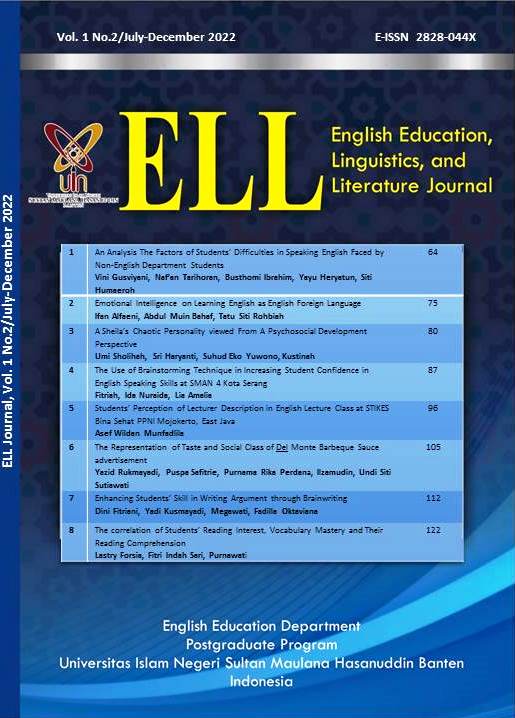A Sheila’s Chaotic Personality Viewed from a Psychosocial Development Perspective
DOI:
https://doi.org/10.32678/ell.v1i2.6557Keywords:
personality, psychosocial developmental perspectiveAbstract
Sheila is a major character in One Child novel written by Torey Hayden. This study attempts to analyze the novel based on its’ structural elements and to explore Sheila’s chaotic personality based on psychosocial developmental perspective proposed by Erik H Erikson. This research belongs to qualitative research which employs textual data. Textual data are taken from two sources; namely the novel itself as primary data source and the other materials which are related to the study as secondary data source. The technique of data collection is library research. The technique of data analyzing in this study is descriptive. The result of this study shows that the structural elements of the novel present a unity. It appears in the exposition, complication, climax, and resolution of the story. Furthermore, the psychosocial developmental analysis shows Sheila’s chaotic personality mostly caused by her past traumatic experience in her early life. Sheila had past traumatic and chaotic personality namely Mistrust (in stage infancy: birth – 1 year), Shame and Doubt (in stage early childhood: 2-3 years), 3) Guilt (in stage preschool age: 4-5 years), and 4) Inferiority (in stage school age: 6-12 years). The early life of Sheila was not told clearly, but Hayden just told the crucial event and condition of Sheila that made her become destructive, uncontrollable child, and has chaotic personality. Sheila tried to solve her crisis to develop her healthy ego development.
Downloads
References
Baron, R. A. and Byrne, D. 1983. Social Psychology. Understanding Human Interaction. 5th ed. Boston: Allyn & Bacon.
Corsini, Raymond J. 1987. Concise Encyclopedia of Psychology. New York: A Wiley Interscience Publication.
______. 1994. Encyclopedia of Psychology 2nd ed. Vol. 1 .New York: John Willey & Sons.
Dunn, Judy. 2002. Young Children’s Close Relationships beyond Attachment. SAGE Publications.
Hayden, Torey L. 1980. One Child. New York: Avonbooks Harpercollin.
Lefrancois, Guy R. 1984. The Life Span. Belmot Stanford University. Wardworth Publishing Company.
_______. 1986. of Children. An Introduction to Child Development. Fifth Edition. California: A Division of Wardsworth, Inc.
Papalia, Diane E. Dana Gross. Ruth Duskin Feldman. 2003. Child Development. A Topical Approach. Mc. Grow Hill.
Pikunas, Justin. 1976. Human Development. An Emergent Science. 3rd ed. McGrow Hill, Inc.
Semi, M. Atar. 1988. Anatomi Sastra. Padang: Angkasa Raya.
Sujanto, Agus, Halem Lubis, Taufik Hadi. 1991. Psikologi Kepribadian. Surabaya: Bumi Aksara.
Wellek, R and Warren, A. 1984. Theories of Literature. New York: Harcurt, Bruce and World, Inc.
Downloads
Published
Issue
Section
License
Copyright (c) 2022 Umi Sholihah, Sri Haryanti, Suhud Eko Yuwono, Kustinah Kustinah

This work is licensed under a Creative Commons Attribution-ShareAlike 4.0 International License.






